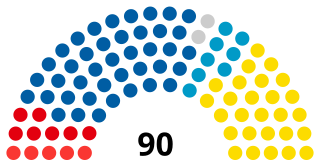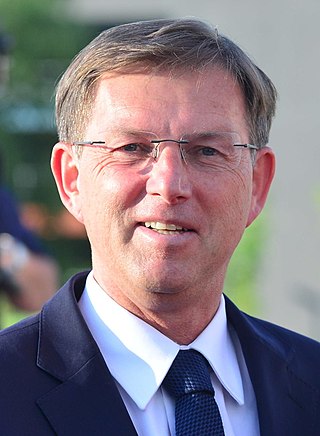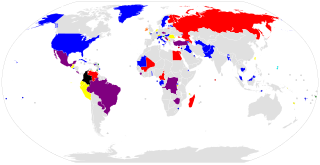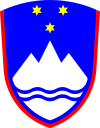The politics of Slovenia takes place in a framework of a parliamentary representative democratic republic, whereby the Prime Minister of Slovenia is the head of government, and of a multi-party system. Executive power is exercised by the Government of Slovenia. Legislative power is vested in the National Assembly and in minor part in the National Council. The judiciary of Slovenia is independent of the executive and the legislature. Slovenia is a Member State of the European Union and is represented in the Council of the EU and through elections to the European Parliament.
Bicameralism is a type of legislature that is divided into two separate assemblies, chambers, or houses, known as a bicameral legislature. Bicameralism is distinguished from unicameralism, in which all members deliberate and vote as a single group. As of 2022, roughly 40% of world's national legislatures are bicameral, while unicameralism represents 60% nationally and much more at the subnational level.
Unicameralism is a type of legislature, which consists of one house or assembly, that legislates and votes as one. Unicameralism has become an increasingly common type of legislature, making up nearly 60% of all national legislatures and an even greater share of subnational legislatures.

The National Assembly is the general representative body of Slovenia. According to the Constitution of Slovenia and the Constitutional Court of Slovenia, it is the major part of the distinctively incompletely bicameral Slovenian Parliament, the legislative branch of the Republic of Slovenia. It has 90 members, elected for a four-year term. 88 members are elected using the party-list proportional representation system and the remaining two, using the Borda count, by the Hungarian and Italian-speaking ethnic minorities, who have an absolute veto in matters concerning their ethnic groups.
Same-sex marriage has been legal in Slovenia since 9 July 2022 in accordance with a ruling from the Constitutional Court of Slovenia. The court ruled that the ban on same-sex marriages violated the Constitution of Slovenia and gave the Slovenian Parliament six months to amend the law to align with the ruling, although the decision took effect immediately after publication. The National Assembly passed legislation on 4 October 2022, which was overridden by the National Council one week later, but reconfirmed with a final vote in the National Assembly on 18 October 2022.

The Slovenian National Party is a nationalist political party in Slovenia led by Zmago Jelinčič Plemeniti. The party is known for its Euroscepticism and opposes Slovenia's membership in NATO. It also engages in what many consider to be historical negationism of events in Slovenia during World War II.

The National Council is according to the Constitution of Slovenia the representative of social, economic, professional and local interest groups in Slovenia and has a legislative function working as a corrective mechanism of the National Assembly, although it does not itself pass acts. It may be regarded as the upper house, but the bicameralism is distinctively incomplete. It is not elected directly by the population, but meant to represent different interest groups in the country. The councillors are elected for a five-year term.

Lesbian, gay, bisexual, and transgender (LGBT) rights in Slovenia have significantly evolved over time, and are considered among the most advanced in Eastern Europe. Slovenia was the first post-communist country to have legalised same-sex marriage.
House of Representatives is the name of legislative bodies in many countries and sub-national entities. In many countries, the House of Representatives is the lower house of a bicameral legislature, with the corresponding upper house often called a "Senate". In some countries, the House of Representatives is the sole chamber of a unicameral legislature.

The National Assembly Building (Slovene: Zgradba Državnega zbora, also colloquially the Parliament in Ljubljana, the capital of Slovenia, is a modernist palace housing the legislature of Slovenia. Built between 1954 and 1959 by the architect Vinko Glanz, it is a three-storey building with an area of 2,200 m2. It is located on the Republic Square in the center of Ljubljana. Annual visitor numbers are around 13,000.
This national electoral calendar for 2010 lists the national/federal elections held in 2010 in all sovereign states and their dependent territories. By-elections are excluded, though national referendums are included.
The Government of the Republic of Slovenia exercises executive authority in Slovenia pursuant to the Constitution and the laws of Slovenia. It is also the highest administrative authority in Slovenia.

The judiciary in Slovenia is one of the three constitutional branches of government and is independent of the other two. Judges enjoy a permanent mandate and are appointed by the National Assembly after they have been nominated by the Judicial Council, which itself is not part of the judicial branch of the government.

This national electoral calendar for 2012 lists the national/federal elections held in 2012 in all sovereign states and their dependent territories. By-elections are excluded, though national referendums are included.

The Assembly of the Delegates of the Slovene Nation or the Kočevje Assembly was the session held in Kočevje in what is now southern Slovenia over the period 1–3 October 1943 by the highest representative body of the anti-fascist Partisan movement in Slovenia during World War II. The assembly elected the legislative body of the Slovene liberated areas.

This national electoral calendar for 2017 lists the national/federal elections held in 2017 in all sovereign states and their dependent territories. By-elections are excluded, though national referendums are included.

Miroslav Cerar Jr. is a Slovenian law professor and politician. He was Prime Minister of Slovenia, leading the 12th Government. He served as Deputy Prime Minister and Minister of Foreign Affairs in the 13th Government. He is a full professor at the Chair of Theory and Sociology of Law at the University of Ljubljana Faculty of Law.

This national electoral calendar for 2018 lists the national/federal elections held in 2018 in all sovereign states and their dependent territories. By-elections are excluded, though national referendums are included.














